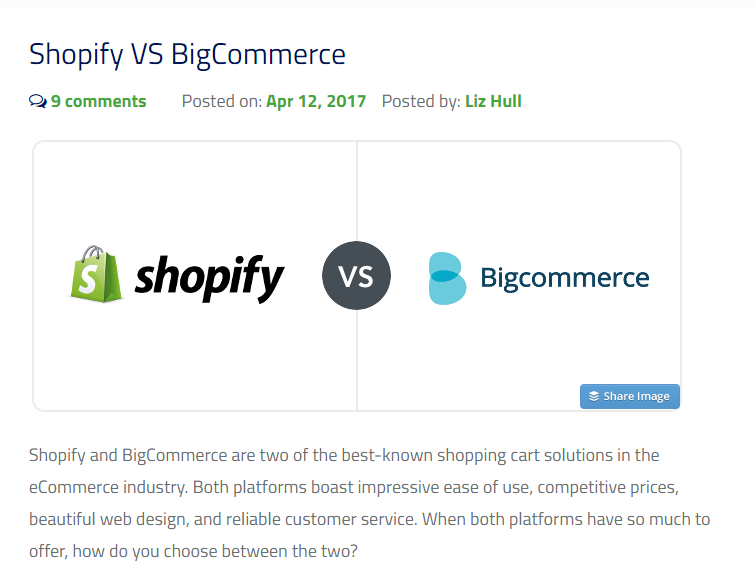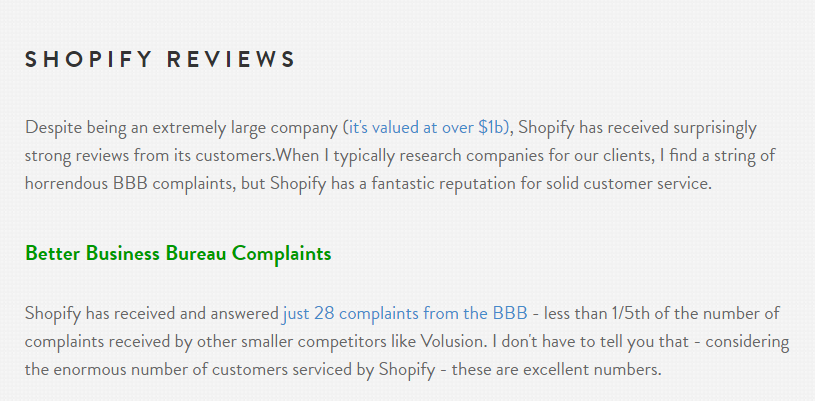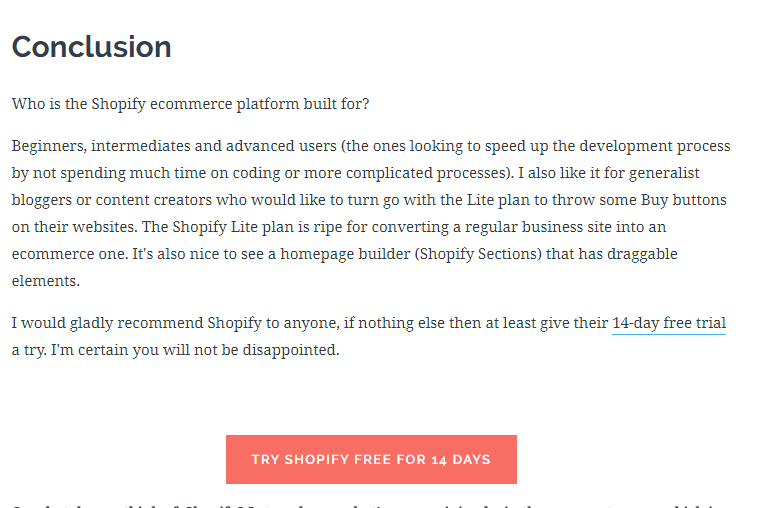You’ve joined the Shopify Affiliate Program, or maybe you’re a web designer or developer who's curious about earning passive income. However, you got here, you’re now ready to start promoting Shopify and earning commissions.
You’ve done your research and know your talking points. You’ve written articles and blog posts before, so this should be a breeze. So why are you staring blankly at a blinking cursor?
Don’t panic! Writers’ block is completely normal and I’m here to help. Here are four steps to creating a top-performing affiliate post.
1. It’s all about you

Remember when you were young and your parents said, “it’s not all about you”? Well, they were wrong. When it comes to influencing a purchase, it truly is all about you.
Your followers engage with your social media and posts because they relate to you. They may even want to be like you! This is what makes you a powerful influencer and a great affiliate. Don’t lose that personal touch simply because you are now monetizing your site. Keep the voice and tone you’ve already established on your site.
Don’t lose that personal touch simply because you are now monetizing your site.
Sharing your own personality is engaging and increases your credibility. Below are some tips to ensure your posts are as unique as you :
:
- Share your honest opinion based on your personal experiences with the platform.
- Be transparent. Let your followers know you have affiliate links in the post, and explain why you are an affiliate. Your reason could be anything from supporting the costs of the blog, to funding your latest business venture.
- Images should be your own versus stock photography or generic screenshots.
- Only review products that make sense with your blog and for your audience. If you’re a traditional beauty blogger, a Shopify review wouldn’t be consistent with your content, and could lose you credibility. Now if you’re a beauty blogger who writes about how beauty bloggers can increase income through an online store, you have a great opportunity to be a Shopify Affiliate.
You might also like: What is Affiliate Marketing? The Myth vs. Reality.
2. Know your audience
As an affiliate marketer, you’ll want to write articles that promote some of Shopify’s hundreds of amazing features and apps. Don’t list all of these features in one, long, bullet-pointed list. A long list can be overwhelming and overlooked as a result.
Instead, select the products and integrations that are most relevant to your audience and explain the value to them. This creates a stronger connection and call-to-action for your follower. The follower will understand exactly how this feature is relevant to their business.
Keep your messaging personal and within your niche.
Keep your messaging personal and within your niche. The key is to know your audience, and to ask yourself the right questions before you begin writing your post. Questions such as:
The key is to know your audience, and to ask yourself the right questions before you begin writing your post. Questions such as:
- What feature is most important to my audience?
- What will make my audience want to click on my affiliate link?
- Which offer or benefit will entice them the most: a free trial or speed to launch?
Below are examples of niches, and how to create content for each niche’s specific needs.
Is your audience less technical and more creative? If your audience creates home crafted goods, focus on the usability of Shopify. Recommend templates that work well for this genre. Discuss which business tools you used to successfully launch your business.

Are you speaking to serial entrepreneurs? In this case, focus on cross selling opportunities, speed to launch, and ease of expansion. Give examples of successful entrepreneurs who have launched ecommerce businesses on Shopify, such as Tony Robbins, Tim Ferriss, and Daymond John.
Have a technical audience? Discuss the open Shopify platform, access to a development store as a Shopify Partner, and the ability to customize the user experience. Address how Shopify saves programmers’ time with thousands of apps that engage customers and increase sales.
3. Build credibility
Before you write an affiliate post, it’s essential to first build trust with your audience. People buy from people they trust. Trust is built through sharing valuable non-monetized content, and by providing followers with detailed and helpful information.
People buy from people they trust. Trust is built through sharing valuable non-monetized content, and by providing followers with detailed and helpful information.
Before you write an affiliate post, it’s essential to first build trust with your audience.
This trust should be built before you share your first affiliate post with thoughtful and valuable engagement and content. Once the initial trust is established, here are four ways to increase trust within your affiliate post:
- Compare and contrast. As an affiliate, you can compare other brands and products. Showing you’ve done your research with competitors builds trust with your audience. It shows you have looked at all the options and are presenting an unbiased view.

- Get personal. Yes, we are back to it being all about you. Discuss your personal experiences and be real. Don’t just talk about your successes, but also address your challenges, and how you overcame them. Tell your followers why you recommend and use Shopify.

- Use outside references. When creating an affiliate post, don’t hesitate to quote outside references. These quotes can be in the form of testimonials or ecommerce statistics. When using outside resources, be sure they’re from credible and recognizable sites, such as major magazines, newspapers, or research firms.

- Don’t be camera shy. According to 70 percent of marketers, video produces more conversions than any other type of content. Let your readers see and hear you through video. YouTube videos are ideal to embed because they also help with search engine optimization.
According to 70 percent of marketers, video produces more conversions than any other type of content.
Keep in mind, credibility builds throughout your entire site by consistently providing valuable information to your followers. Each of the tips above can be applied to all posts, affiliate and otherwise.
You might also like: 7 Tips to Help Cultivate Authenticity for your Affiliate Marketing Business.
4. Be obvious
Now is not the time to be shy. Make your affiliate links obvious and compelling. Many affiliates provide subtle links hidden within the copy. It’s simply the word Shopify with a hyperlink. There is no call to action, such as a free trial or an “Buy Now” link.
Now is not the time to be shy.
Instead, you need to make it clear what you would like your follower to do, and give the follower a reason to click. Below are the key placements for affiliate links.
- Consider the beginning, middle, and end. While we would like to believe our readers stay with our post from the first word to the last, the reality is they probably won’t. Include affiliate links at the beginning, middle, and end of the post to improve click-through rates and post engagement.

- Include ad banners. Text links will always be your top converting affiliate links. However, don’t discount banners — these images serve as a clear and visual reminder for your followers to click.
- Have a strong call to action. Simply telling your readers to click on a link will not lead to great conversions. If your follower only sees an underlined word, you’re expecting the follower to guess that s/he should click on that word. You need to explain clearly the reason for clicking. A link that contains a time-sensitive call to action with an incentive converts the best. Examples of strong calls to action are “Click Here For A Free Trial” or “Click Here And Launch Your Store in 48 Hours.” Give your audience a reason to click.

Let the world know
Following these four tips gives you the framework for a successful affiliate post. Whether you’re just starting out or are a veteran in affiliate marketing, staying true to your audience and yourself should always be a guiding point with all affiliate marketing tactics.
Whether you’re just starting out or are a veteran in affiliate marketing, staying true to your audience and yourself should always be a guiding point with all affiliate marketing tactics.
Once your masterpiece is complete, let the world see it. Ensure your post is optimized properly for the search engines, so people in your niche can easily find your post. Not sure how to optimize your post? Check out Search Engine Watch or Search Engine Journal for detailed instructions.
Finally, don’t leave out your followers. Broadcast your message via your social media channels, such as Facebook, Twitter, LinkedIn, and YouTube. Maximize your existing email list with a targeted email campaign.
Take your time writing your post, broadcast it, and test new marketing tactics to ensure your success as a Shopify affiliate. Happy commission-making!
Read more
- 25 Affiliate Resources You Can’t Miss
- Always Listen to Mo: How Mohamed Ali Aguel Became an Ecommerce Education Superstar
- 5 Content Angles That Only Affiliates Can (and Should) Create
- How Christoph Filgertshofer Became Germany's 18-Year-Old Affiliate Marketing Wunderkind
- New to Your Partner Dashboard: Powerful Affiliate Tools for Campaign Tracking
- Content Monetization: How it Works and Mistakes to Avoid
- 4 Affiliate Marketing Strategies to Sell More in Any Market
What strategies do you use when writing an affiliate blog post? Tell us in the comments below.

